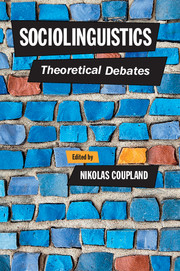Book contents
- Frontmatter
- Contents
- List of contributors
- Preface and acknowledgements
- 1 Introduction: Sociolinguistic theory and the practice of sociolinguistics
- Part I Theorising social meaning
- 2 The “push” of Lautgesetze, the “pull” of enregisterment
- 3 Variation, meaning and social change
- 4 Indexicality, stance and fields in sociolinguistics
- 5 Sociolinguistic differentiation
- Part II Language, markets and materiality
- Part III Sociolinguistics, place and mobility
- Part IV Power, mediation and critical sociolinguistics
- Part V Sociolinguistics, contexts and impact
- Part VI The evolution of sociolinguistic theory
- Index
- References
4 - Indexicality, stance and fields in sociolinguistics
from Part I - Theorising social meaning
Published online by Cambridge University Press: 05 June 2016
- Frontmatter
- Contents
- List of contributors
- Preface and acknowledgements
- 1 Introduction: Sociolinguistic theory and the practice of sociolinguistics
- Part I Theorising social meaning
- 2 The “push” of Lautgesetze, the “pull” of enregisterment
- 3 Variation, meaning and social change
- 4 Indexicality, stance and fields in sociolinguistics
- 5 Sociolinguistic differentiation
- Part II Language, markets and materiality
- Part III Sociolinguistics, place and mobility
- Part IV Power, mediation and critical sociolinguistics
- Part V Sociolinguistics, contexts and impact
- Part VI The evolution of sociolinguistic theory
- Index
- References
Summary
In the recent history of the field of sociolinguistics, the concept of indexicality has been a productive lens for a central disciplinary focus on conventional/stereotypical relationships between linguistic forms and social meanings. These conventionalized associations have been the basis for studies of a wide range of communicative practices, where they are building blocks or resources in performance and stance-taking and components of styles or registers. They also underpin many critical sociolinguistic projects focused on the social evaluation of communicative practice and its social, political, and ideological implications.
Indexicality has also been central to the understanding of linguistic practice as context-sensitive and context-creating (see Kiesling 2009: 177) and the companion perspective on meaning as both conventional and emergent. In this chapter, I review these principles with an emphasis on processes of indexicalization: how indexical meanings accrue to particular forms, how indexicals at one level (or “order”) are projected onto subsequent orders (Silverstein 2003), and how indexicals are organized into fields (Eckert 2008). I argue that taken together, these approaches constitute a motivated, empirically grounded framework for documenting and understanding sociolinguistic continuity and change.
In this examination of processes of indexicalization, I join many other scholars in focusing on ideology. I make a modest effort to expand this conversation by drawing attention to the sometimes implicit ways in which analyses of indexicality and indexicalization in sociolinguistic analyses have been framed in relation to iconicity and iconization. In doing so, I treat Peirce's famous trichotomy of sign modalities into symbol, index, and icon according to the relationship between the sign and what it stands for (its “object”) not just as a typology but as itself a set of dynamic relationships that frame the production and interpretation of meaning.
The distinction that Peirce formalized between indexes and icons revolves around the degree to which particular signs are treated as “fused” with their objects. Indexes have a relationship of contiguity (pointing/association) with what they stand for; icons have relationship of formal (“natural”) similarity or resemblance; icons are thus more “fused” with their objects than indexes. Much sociolinguistic work on processes of indexicalization has focused on the way in which indexical associations come to be conventional, potentially so conventional as to undergo iconization as “styles” (Coupland 2007), “persona styles” (Coupland 2002; Eckert 2008: 456), or “registers” (Agha 2007).
- Type
- Chapter
- Information
- SociolinguisticsTheoretical Debates, pp. 86 - 112Publisher: Cambridge University PressPrint publication year: 2016
References
- 43
- Cited by



